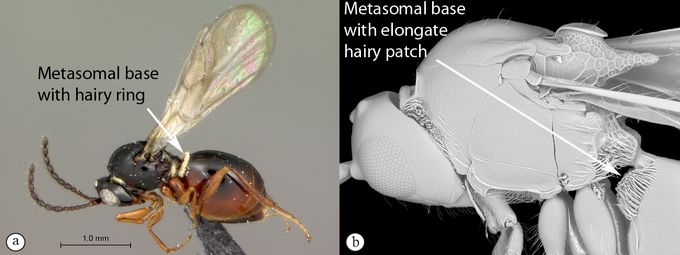
1. Metasomal base with hairy ring (a) or elongate hair patches laterally (b) …
2
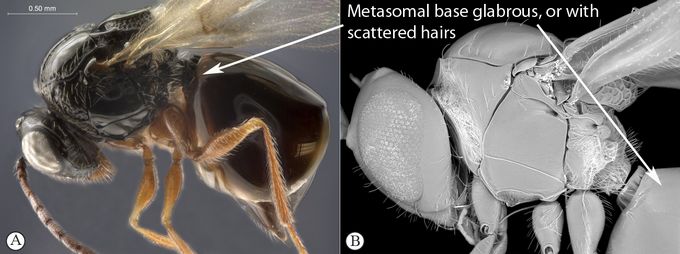
— Metasomal base glabrous (A) or with scattered hairs only (B) …
24

2. Forewing emarginated (a); reduced wing venation with open marginal cell (a);
usually with partial reduction of wing pubescence. Scutellum longitudinally
striate with a narrow scutellar plate (b). Posteroventral corner of metapleuron
pointedly protruding (c). Head bulbous with relatively small eyes (c) …
Kleidotoma (Kleidotomini)

— Wings not distinctly emarginated (A); wing venation more complete, marginal
cell open, partially closed, or completely closed (A). Scutellum variable, but
very rarely with a striate scutellum and narrow scutellar disc (B). Metapleural
corner not protruding (C). Head variable, but rarely bulbous with small eyes …
3
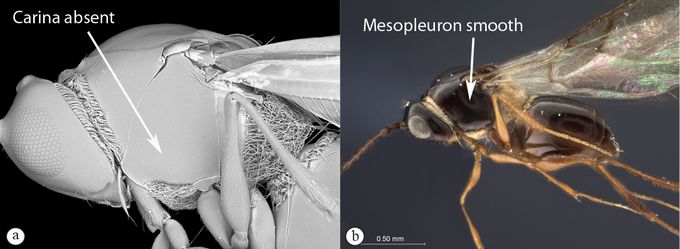
3. Mesopleural line absent (a, b); mesopleuron entirely smooth (a, b) …
4
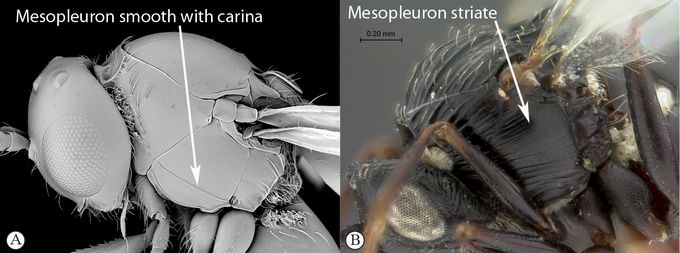
— Mesopleural line present (A), or mesopleuron heavily striate (B) …
6
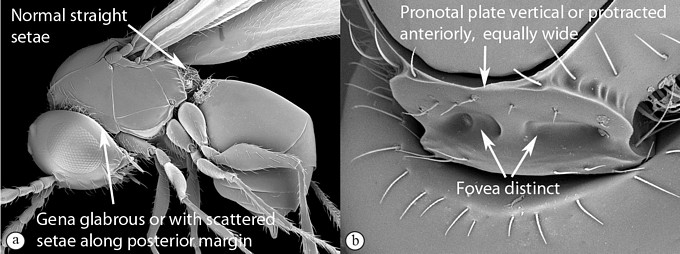
4. Foamy setae absent on propodeum and metasomal base; normal straight setae
present (a), or glabrous. Gena glabrous, or with a few scattered setae (a).
Pronotal plate either vertical or protracted anteriorly, with anterior and
posterior halves roughly the same width (b); fovea present, distinct (b) …
5
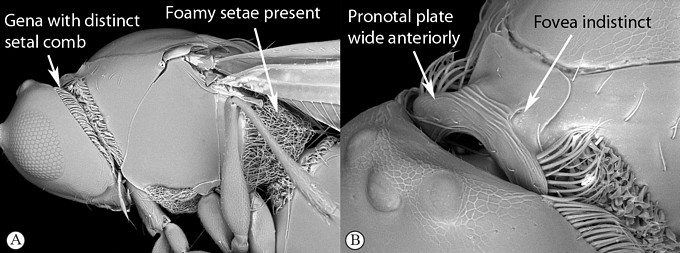
— 'Foamy', reticulate setae present on propodeum and anterior base of metasoma
(A). Distinct setal line present along gena (A). Pronotal plate protracted
anteriorly, anterior half distinctly wider than posterior half (B), lateral
fovea shallow, nearly indistinct (B) …
Leptolamina (Leptolamina
group)
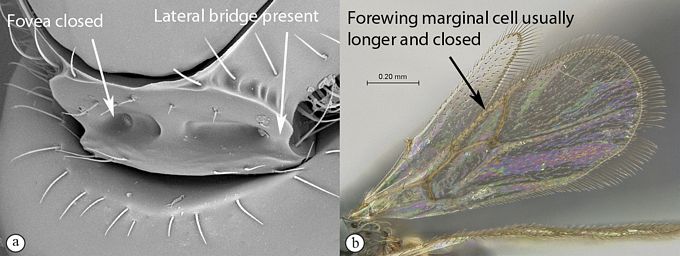
5. Fovea on pronotal plate closed, lateral bridge present (a). Forewing marginal
cell usually longer and closed (b) …
Rhoptromeris (in part)
(Trichoplastini)
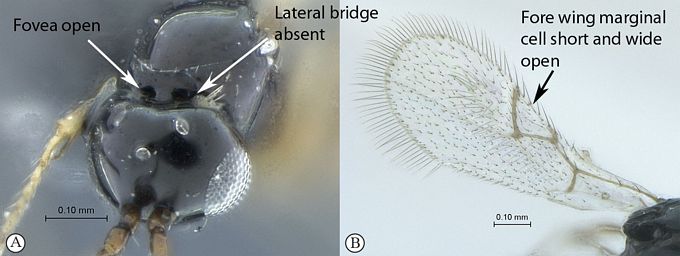
— Fovea on pronotal plate open,
lateral bridge absent (A). Fore
wing marginal cell short and wide open (B). Tiny wasps
…
Micreriodes (Leptolamina
group)
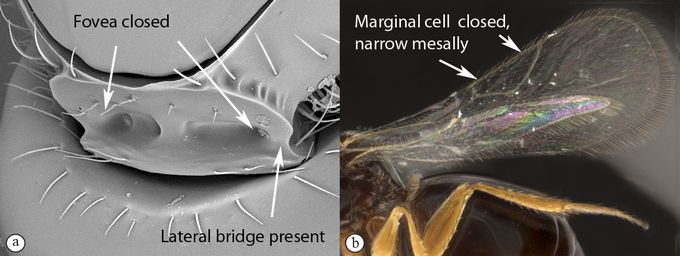
6. Pronotal plate with closed lateral foveae, lateral bridges present (a).
Forewings narrow (b); marginal cell closed, distinctly narrow mesally (b).
Species typically more or less laterally compressed … Trichoplastini
7
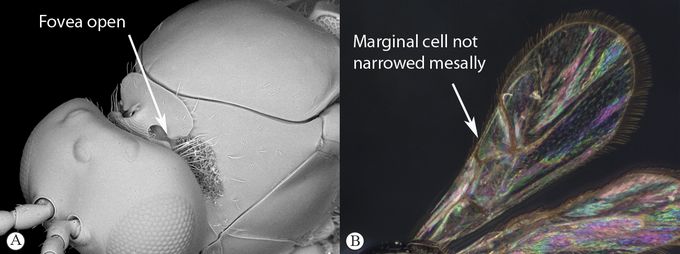
— Pronotal plate with lateral foveae open (A), or fovea too shallow to see.
Forewings narrow to broad; marginal cell open, partially open, or closed; shape
of marginal cell more symmetrical, not narrowed mesally (B) …
12
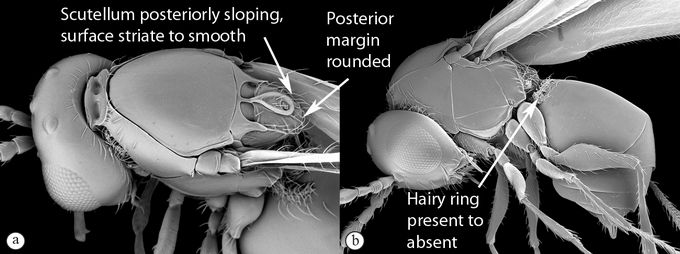
7. Posterior part of scutellum strongly sloping, rarely overhanging propodeum
(a); dorsal surface of scutellum distinctly longitudinally striate to smooth,
occasionally foveate (a); posterior margin of scutellum rounded, not drawn out
into a spine (a). Posterior margin of metapleuron occasionally with a distinct
cavity. Hairy ring of metasoma ranging from entire to absent (b) …
8
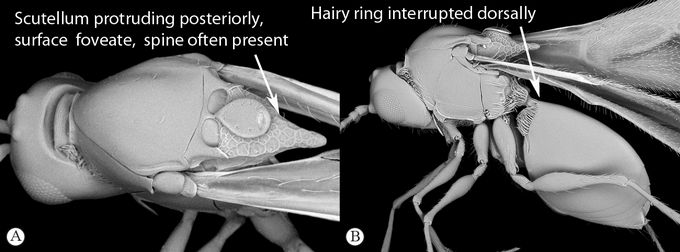
— Posterior part of scutellum protruding posteriorly, overhanging propodeum (A);
dorsal surface of scutellum foveate (A), never striate or smooth; posterior
margin of scutellum often drawn out to a distinct spine (A, B). Posterior margin
of metapleuron always entire. Hairy ring at base of metasoma usually broadly
interrupted dorsally (B) … 10
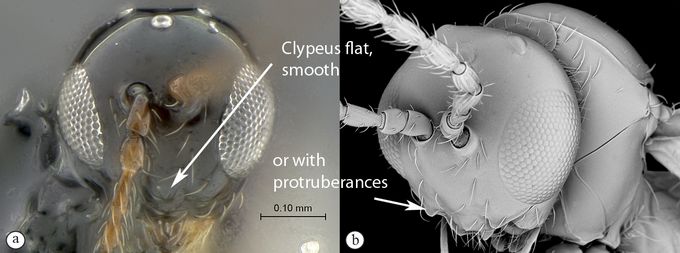
8. Clypeus typically flat and smooth (a); rarely bifurcate with single small
medial conical protuberance (b). Mandibles of normal cynipoid appearance,
triangular, not enlarged. All sizes, usually small or medium sized. Very common
… 9
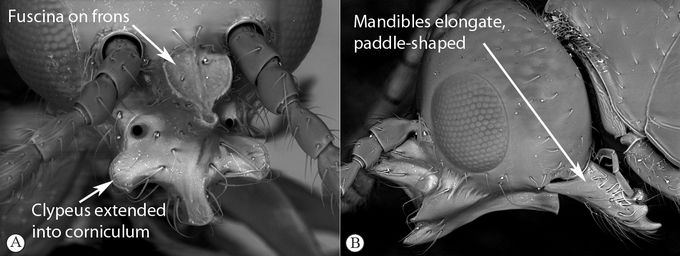
— Clypeus extended into a massive corniculum, with a fuscina on frons (A);
mandibles elongate, paddle-shaped (B). Very rare …
Nanocthulhu
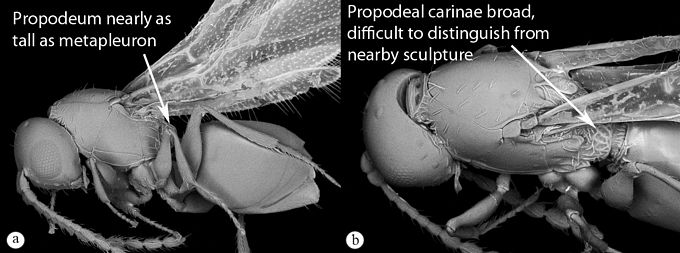
9.
Propodeum, in lateral view, nearly as tall as metapleuron (a), nearly
parallel-sided, hardly tapering posteriorly; propodeal carinae broad, difficult
to distinguish from nearby sculpture (b), gently divergent; rare …
Garudella
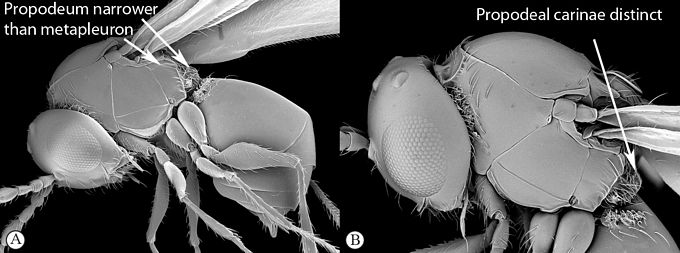
— Propodeum, in lateral view, much narrower than metapleuron (A), distinctly
tapering posteriorly; propodeal carinae very distinct from nearby sculpture (B),
nearly parallel; very common …
Rhoptromeris
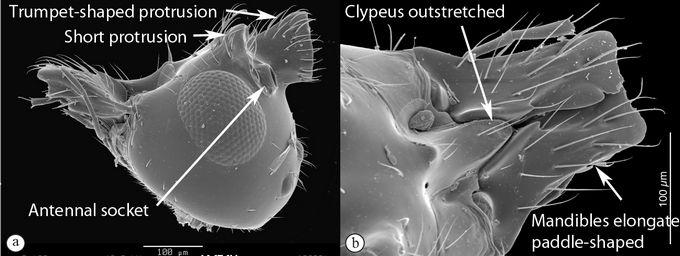
10. Face with trumpet-shaped anteroventral protrusion between toruli (a); short
paired anterior protrusions present under antennal sockets (a). Clypeus
ventrally outstretched (b); mandibles elongate, paddle-shaped (b) …
Stentorceps
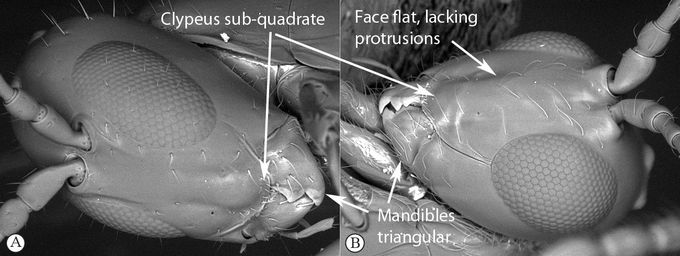
— Face flat, lacking protrusions (A, B); protrusions from ventral margin of
toruli absent (B). Clypeus sub-quadrate, not outstretched (A, B); mandibles
triangular (A, B) … 11
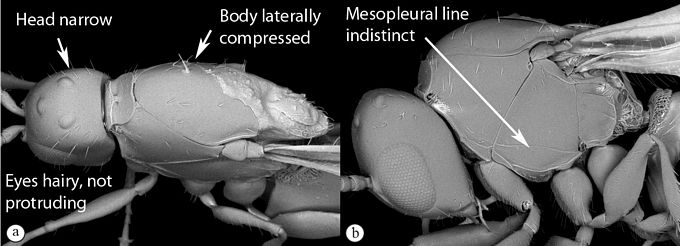
11. Entire wasp laterally compressed, narrow, with a protruding head (a); head
more than twice as long as wide, eyes hairy and scarcely protruding from outline
of head capsule (a). Mesopleural line indistinct and very low on metapleuron (b)
…
Angustacorpa
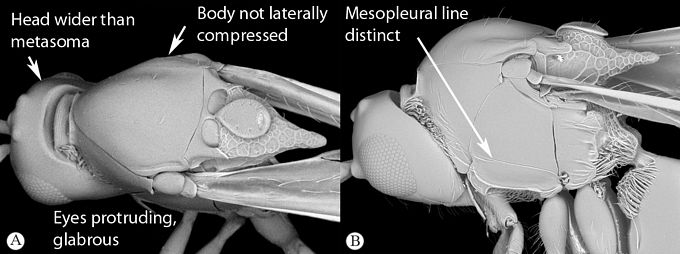
— Normally shaped, or rarely laterally compressed, head normally transversal. Head
about as long as wide, occasionally slightly longer than wide (A). Eyes always
protruding from outline of head capsule, head always wider than metasoma, eyes
glabrous (A). Mesopleural line distinct (B) …
Trichoplasta
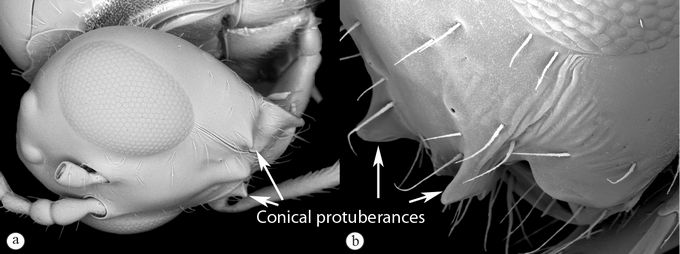
12. Conical protuberances on clypeus and malar space (a, b) …
13
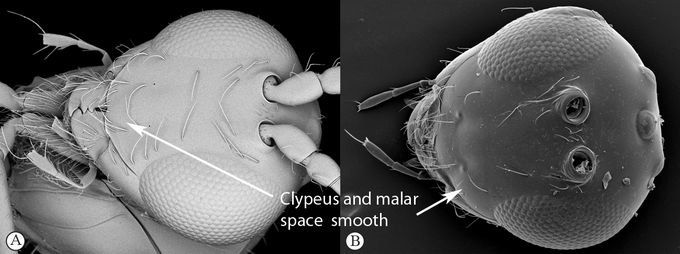
— Protuberances on clypeus and malar space absent (A, B) …
14
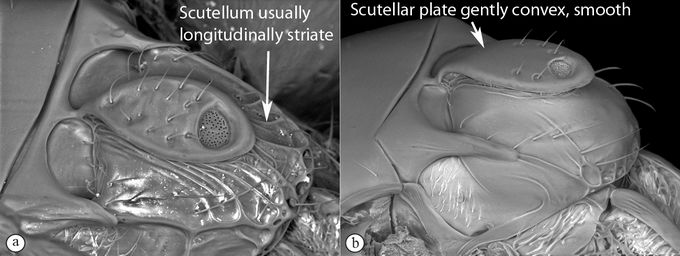
13. Dorsal surface of the scutellum usually longitudinally striate (a).
Scutellar plate gently convex, smooth (b). Commonly collected …
Hexacola
(in part) (Ganaspini)
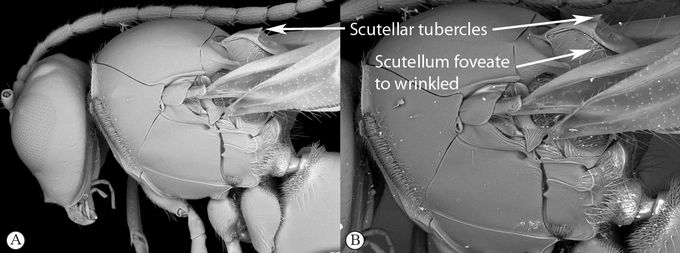
— Dorsal surface of scutellum foveate to wrinkled, not striate (B). Scutellar
plate flat with a pair of tubercles present just anterior to the glandularl pit
(A, B). Rare …
Ganaspidium (Diglyphosematini)
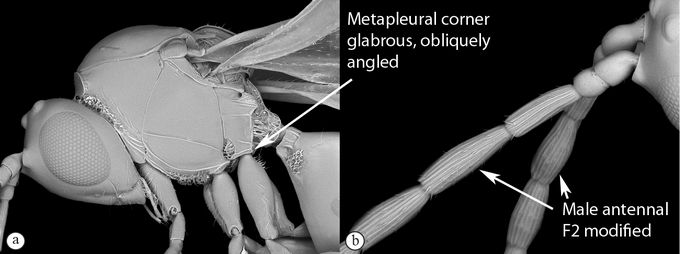
14. Posteroventral corner of metapleuron glabrous, obliquely angled, corner
often raised and forming a more or less triangular surface facing
posterolaterally (a). Antennal F2 modified in males, more or less asymmetric,
more so than F1 (or rarely only as much as F1) (b) …
15 (Eucoilini)
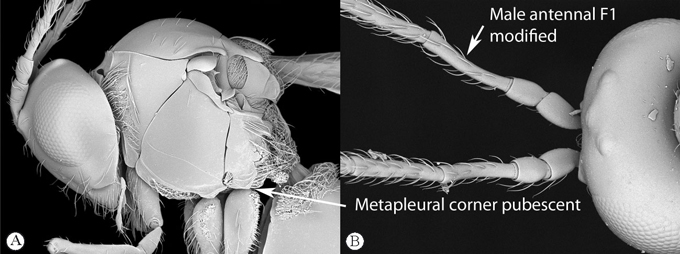
— Posteroventral corner of metapleuron always pubescent, angle often rectilinear
or pointed (rarely oblique), never raised or forming a particular surface (A).
Antennal F1 modified in males, asymmetric and more or less strongly curved (B),
while F2 is not modified … 19 (Ganaspini)
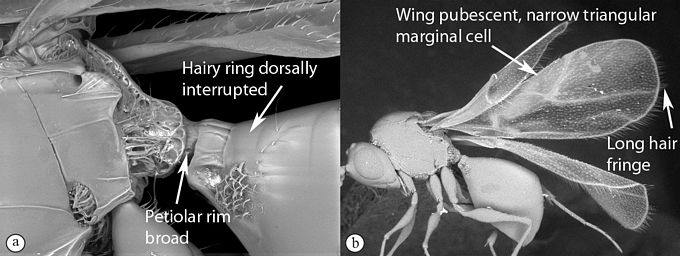
15. Compact wasps, usually small, typically less than 2 mm long. Petiolar rim
broad, hairy ring of metasoma dorsally interrupted (a). Metapleural triangle and
subalar pit moderately developed (b). Wing always pubescent, usually with a
rather narrow triangular marginal cell and a long hair fringe (b) …
Leptopilina
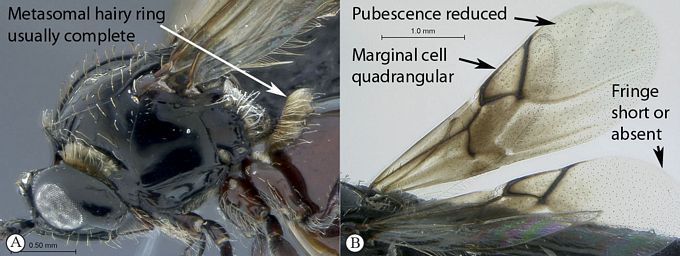
— Often large wasps, commonly over 2 mm in length. Petiolar rim indistinct,
hairy ring of metasoma usually complete (A), occasionally briefly interrupted
dorsally. Metapleural triangle and subalar pit well developed. Wing often with
reduced pubescence (B), usually with a deep and long quadrangular marginal cell
(B), and a short hair fringe (or no hair fringe) (B) …
16
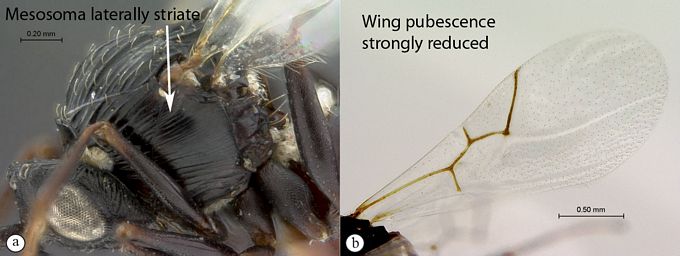
16.
Sides of mesosoma with strongly striate sculpture (a). Strongly reduced
pubescence on wing membrane, usually more or less hairless (b) …
17
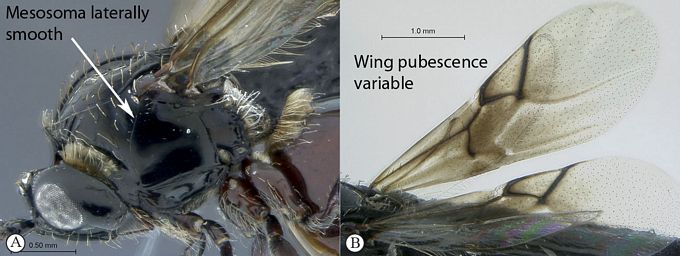
— Sides
of mesosoma without striate sculpture (A). Wing pubescence variable (B) …
18
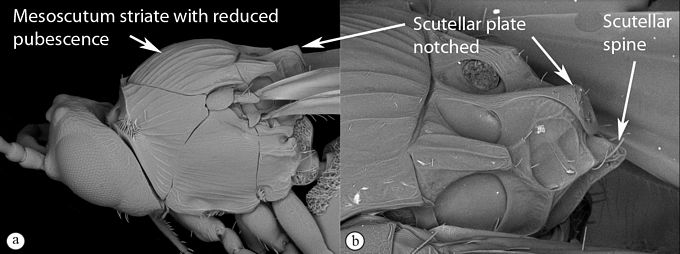
17.
Mesoscutum striate (a). Scutellum with a posterior spine (b), scutellar plate
notched. Pronotum and mesoscutum with strongly reduced pubescence, almost absent
(a, b) …
Afrodontaspis
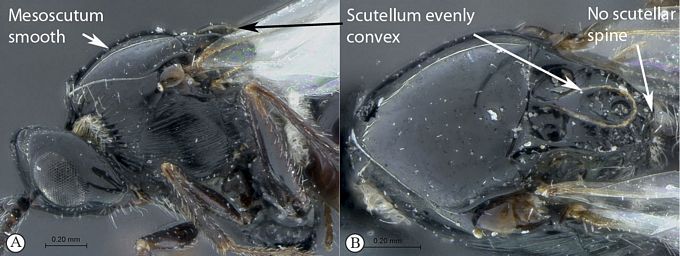
—
Mesoscutum smooth (A, B). Scutellum without a posterior spine, scutellar plate
weakly convex in lateral view (A, B). Pronotum and mesoscutum with scattered
setae (A, B) …
Linoeucoila
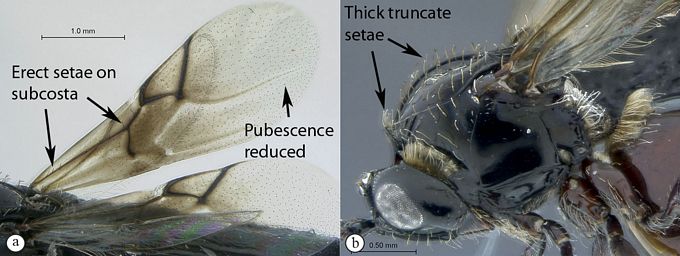
18.
Wing with erect setae on subcosta (a), and often with strongly reduced
pubescence (a). Pronotum (and often mesoscutum) with thick truncate setae (b).
Coxae often with reticulate-vermiculate sculpture. Scutellar plate convex or
even notched, scutellar foveae usually very large ...
Bothrochacis
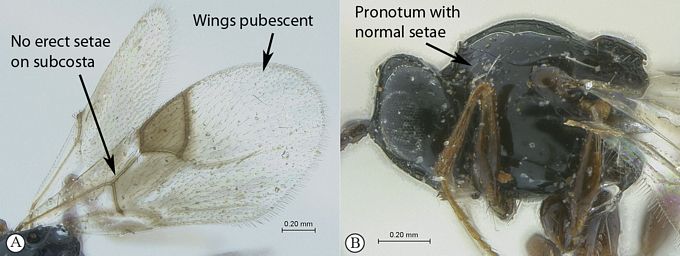
— No
erect setae on subcosta (A). Wing usually normally pubescent (A), sometimes with
reduced pubescence. Pronotum with at most a few thick truncate setae among a
majority of normal, thin and pointed setae (B). Coxae always smooth. Scutellar
plate straight or convex but never notched, scutellar foveae not very large ...
Trybliographa
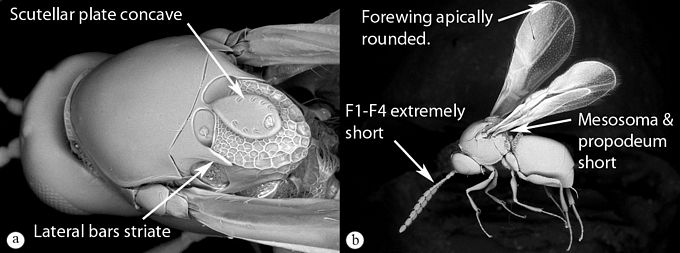
19. Surface of scutellar plate concave, relatively narrow (a). Mesosoma short,
only slightly longer than high (b); propodeum short, not protruding (b).
Marginal cell typically distinctly half-closed (R1 vein along fore margin either
ends or goes abruptly from pigmented to transparent at half length of marginal
cell); occasionally indistinctly so (and sometimes entirely open in very small
specimens). Lateral bars of scutellum typically striate (a). Head typically
transverse (globular in very small specimens). Forewing shape apically rounded
(b). Female antenna with F1–F4 extremely short, annelliform, resulting in a very
striking clava (b) … 20
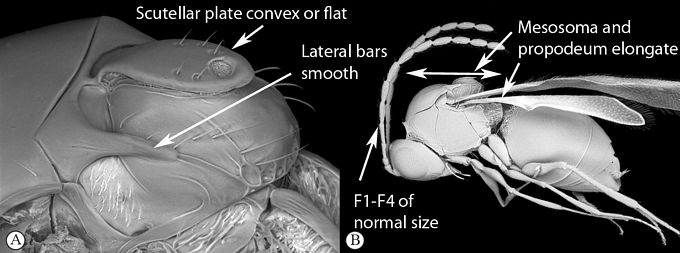
— Surface of scutellar plate convex or flat, often very large (A). Mesosoma
elongate, clearly longer than high (B); propodeum protruding. Marginal cell
variable, open or closed or indistinctly half-closed. Lateral bars of scutellum
typically smooth (A). Head typically deep, often globular. Forewing shape
typically with apex more triangular, truncate or faintly incised. Female antenna
with F1–F4 of normal size (B), clava indistinct or distinct …
21
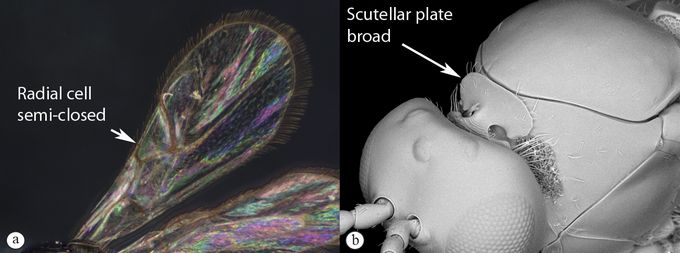
20. Radial cell of fore wing semi-closed (a). Head transverse. Scutellar plate
about as wide as long, not narrow (b). Apical hair fringe of fore wing variable,
typically short (a). Size variable …
Didyctium
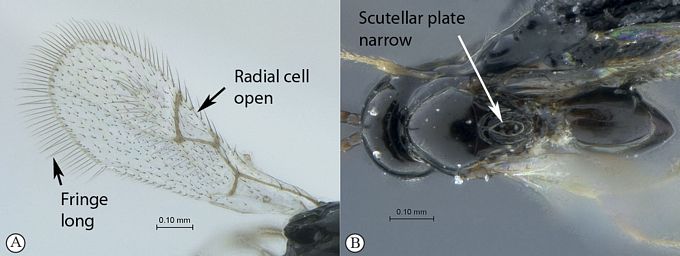
— Radial cell of fore wing open (A). Head globular, about as deep as tall.
Scutellar plate narrow, distinctly longer than wide (B). Apical hair fringe on
fore wing always distinctly long (A). Always tiny (less than 1 mm) (B) …
Endecameris
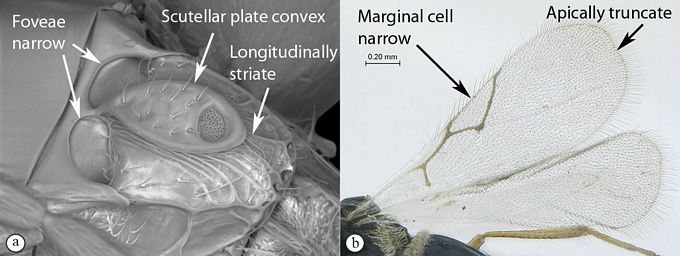
21. Scutellum strongly convex, surface of scutellar plate convex and usually
covering most of scutellum (a): scutellar foveae oriented obliquely relative to
midline (a), dorsal surface of scutellum typically longitudinally striate (a).
Marginal cell narrow, elongate-triangular (2r and RS straight and of equal
length, with an open angle between them), typically closed (b). Wing elongate,
relatively narrow, apically truncate (b). Metacoxae with a small tuft of hairs …
Hexacola
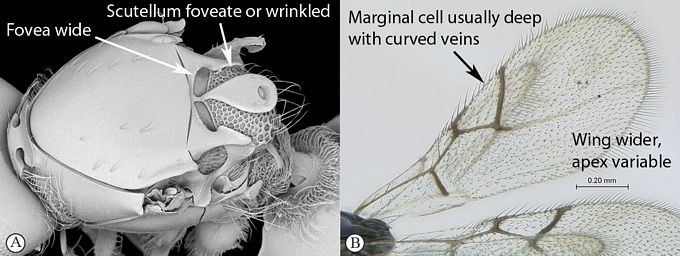
— Scutellum gently convex, surface of scutellar plate flat or convex, of
variable size and width (A); scutellar foveae nearly perpendicular relative to
midline; dorsal surface of scutellum variable, foveate or gently wrinkled, very
rarely longitudinally striate (A). Marginal cell variable, usually deep with
curved veins, open or closed (B). Wing shape wider, apex variable (B). Metacoxae
usually with long hairline (occasionally short) …
22
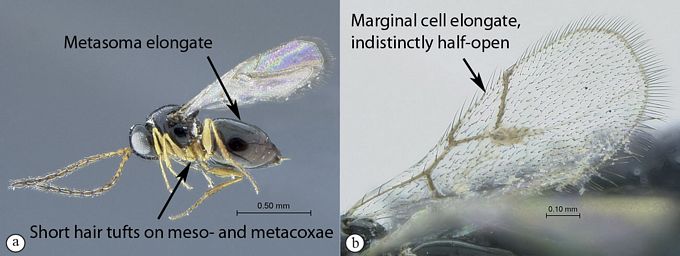
22. Female metasoma extended, elongate (a). Short hair tufts on meso- and
metacoxae. Marginal cell elongate, indistinctly half-open (b) …
Gastraspis
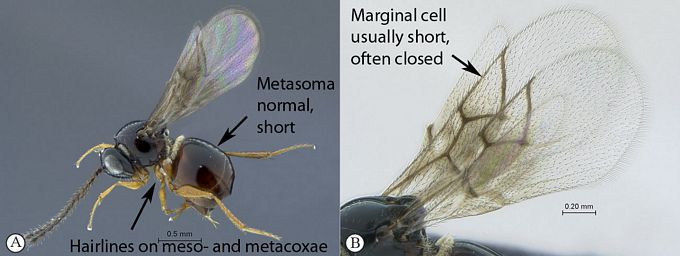
— Female metasoma normal, short (A). Usually hairlines on meso- and metacoxae
(A), sometimes short hair tufts. Marginal cell variable, usually relatively
short and often distinctly closed (B) …
23
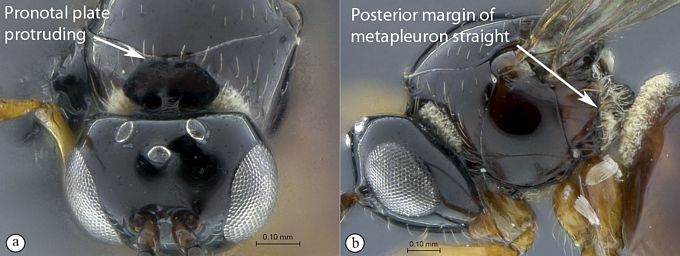
23. Large wasps (2–3 mm), strongly built, black or dark brown wasps with dark
appendages. Pronotal plate more or less protruding over pronotal-mesoscutal
suture (a). Posterior margin of metapleuron straight (b). Rarely collected …
Aganaspis
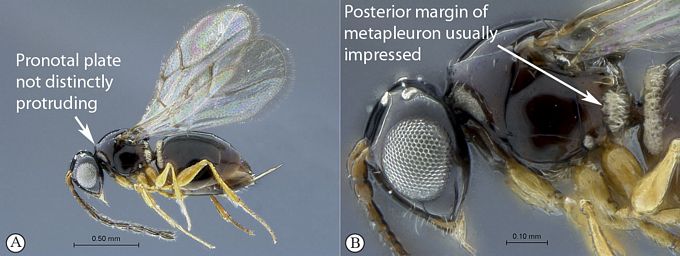
— Typically small, compact or elongate but not strongly built, brown wasps with
usually yellow appendages (sometimes with bi- or tricolored antennae). Pronotal
plate not distinctly protruding over pronotal-mesoscutal suture (A). Posterior
margin of metapleuron usually with a circular or elongate incision (B), rarely
straight. Common …
Ganaspis
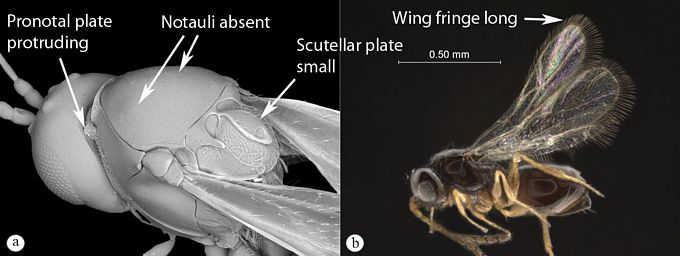
24. Elongate or slender wasps (a, b). Notauli absent (a). Protrusions from lower
face absent. Lateral pronotal carina absent. Antennal F2 modified in male. Hair
fringe on wings long (b). Scutellar plate typically small, thinly elongate or
teardrop shaped, covering less than half of the dorsal surface of the scutellum
(a). Anterior part of pronotal plate protruding (a)…
25
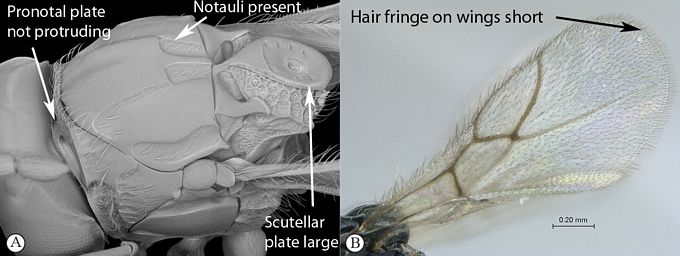
— Compact wasps.. Notauli present, often incomplete mesally, rarely reduced to
mere anterior impressions of the mesoscutum (A). Clypeal and malar protrusions
on face often present. Lateral pronotal carina present to absent. Antennal F1
modified in male. Hair fringe on wings short (B). Scutellar plate often large,
elongate, covering over half of the dorsal surface of the scutellum (A).
Anterior part of pronotal plate not protruding (A) …
27 (Diglyphosematini)
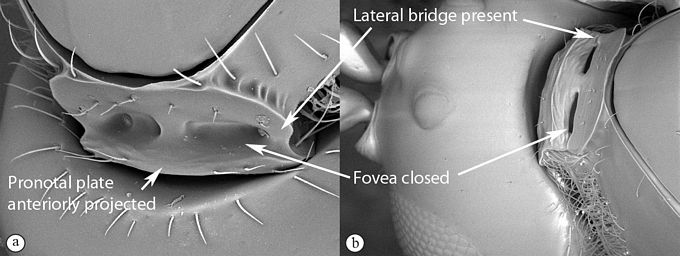
25. Lateral foveae of the pronotal plate closed, lateral bridges complete (a,
b); pronotal plate projected anteriorly (a) …
Rhoptromeris (in part)
(Trichoplastini)
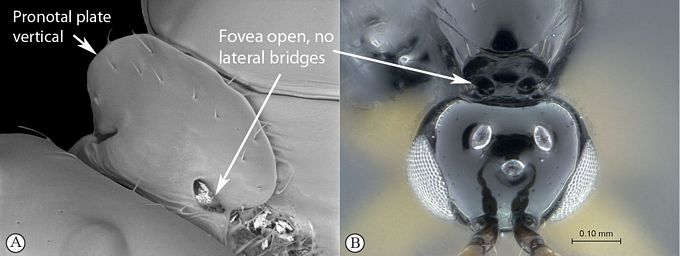
— Lateral fovea of the pronotal plate open, lateral bridges absent (A, B);
pronotal plate typically oriented vertically (A), not projected anteriorly …
26
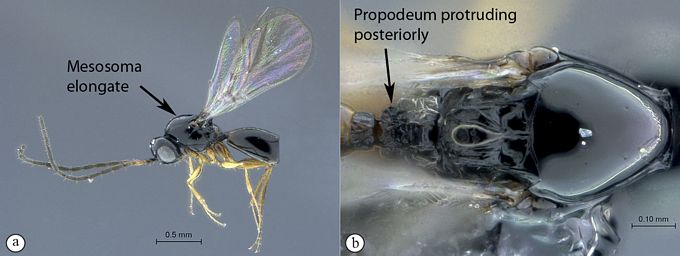
26. Elongate wasps, "diggers", with deep rounded heads, small eyes, strong legs,
and short wings (a). Mesosoma remarkably elongate, much longer than high (a),
with an almost flat mesoscutum (a); propodeum distinctly protruding posteriorly
(b). Rare …
Cothonaspis (Kleidotomini)
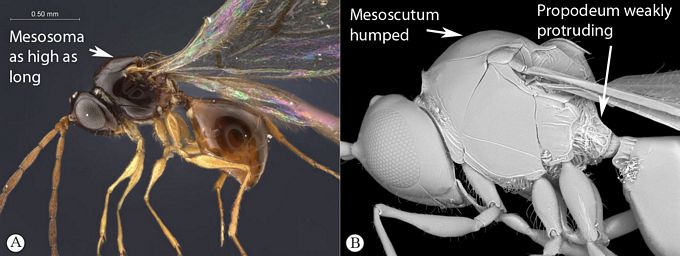
— More or less slender wasps, "flyers", with more or less transverse heads,
large eyes, long legs, and large wings. Mesosoma as high as long (A), mesoscutum
obviously humped (B); propodeum weakly protruding posteriorly (B). Very common …
Leptopilina (in part) (Eucoilini)
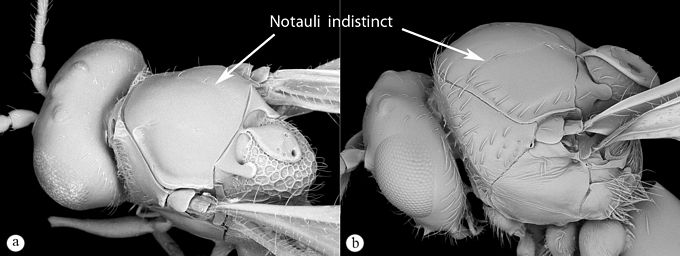
27. Notauli reduced; shortened, shallow and/or indistinct (a, b) …
28

— Notauli well-developed; deep, wide and often sculptured (A, B) … 29
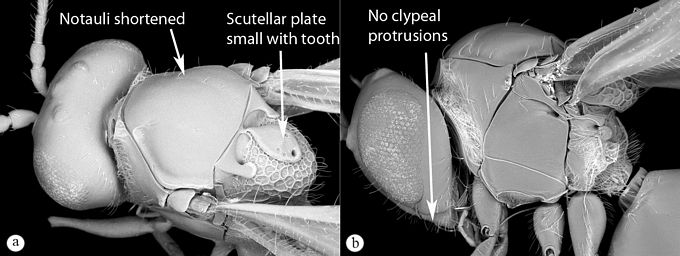
28. Notauli shortened, only anteriormost part visible, indistinct over the rest
of the mesoscutum (a). Face without protrusions (b). Scutellar plate small, with
tooth just anterior to glandular pit (a); scutellum broadly rounded posteriorly,
distinct posterior face absent (a) …
Ealata

— Notauli shallow and indistinct for their entire length, often not visible in
middle of mesoscutum (A). Clypeus and malar spaces each with a single conical or
pyramidal protrusion, sometimes reduced (B). Scutellar plate large, flat, often
with several small paired protuberances along the perimeter; scutellum with
distinct posterior face, ventral to gentle ledge along posterior margin of
scutellum …
Nordlanderia
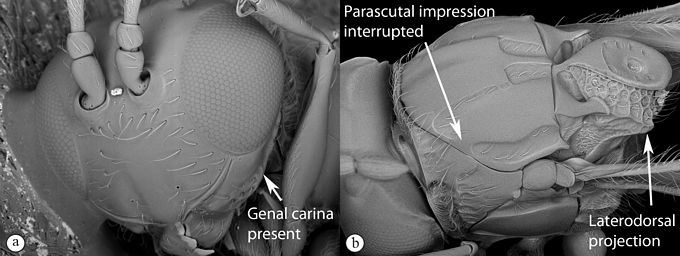
29. Genal carina present (a). Scutellum with faint laterodorsal projections (b).
Parascutal impression interrupted near origin of notauli (b) …
Paradiglyphosema

— Genal carina absent, gena rounded (A). Scutellum without laterodorsal
projections. Parascutal impression complete, not interrupted (B) …
30
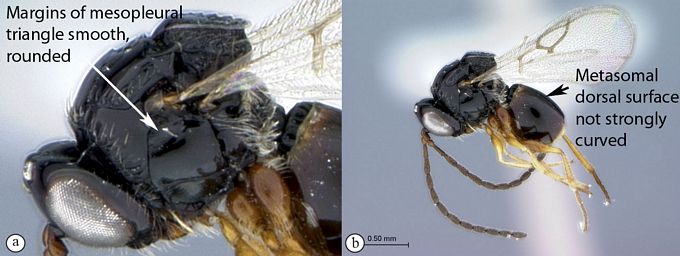
30. Dorsal and ventral margins of mesopleural triangle smooth, rounded,
indistinct (a). Female metasoma directed posteriorly, dorsal surface not
strongly curved downward (b) …
Gronotoma
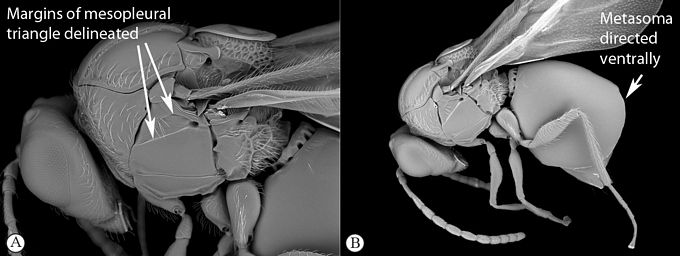
— Dorsal and ventral margins of mesopleural triangle cleft, distinctly
delineated (A). Female metasoma directed ventrally, dorsal surface strongly
curved downward (B) …
Afrostilba
|